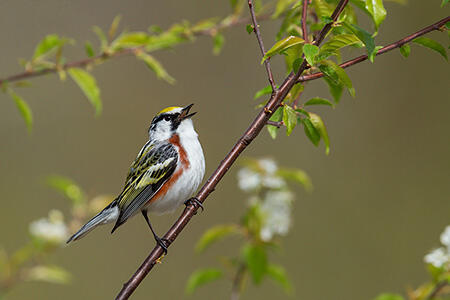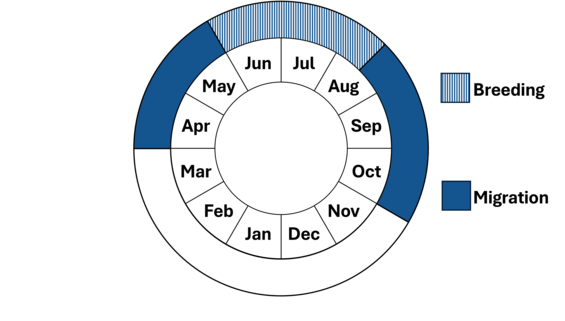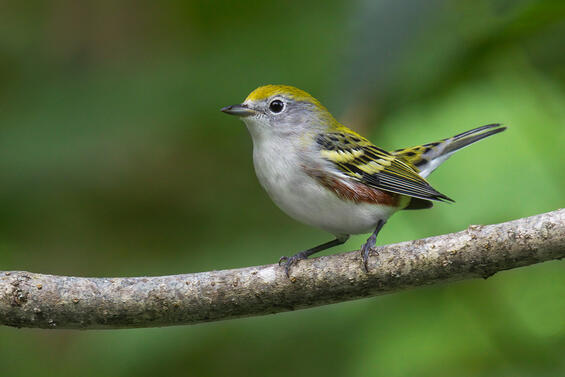- Scientific name: Setophaga pensylvanica
Species of Greatest Conservation Need (MA State Wildlife Action Plan)
Description

Chestnut-sided warbler (Setophaga pensylvanica)
Breeding male chestnut-sided warblers have a distinct yellow crown, chestnut on the flanks, and black facial markings with black and white stripes along the back and a white underside. Nonbreeding adult males maintain chestnut-colored flanks but are otherwise less striking with an olive-colored crown and back and a gray face and underside. Breeding females are distinguished from males by having a greenish color to the crown, less black facial markings, and chestnut coloration on the sides. Immature birds have fewer dark markings along the back and little to no chestnut coloration. Although their song can be variable, it is often likened to the phrase, “pleased, pleased, pleased to meet you.”
Life cycle and behavior

The chestnut-sided warbler’s breeding season starts in May when they arrive from Central and South America and the Caribbean. Chestnut-sided warblers build cup-shaped nests in low bushes in young deciduous woodlands and lay 3-5 creamy white to green eggs with brown speckles. Females incubate these eggs for about 11-12 days, and the young fledge after about 9 to 12 days of hatching. Fall migration typically begins between late August and late September.
Population status

Chestnut-sided warbler (Setophaga pensylvanica)
According to the Breeding Bird Survey, in Massachusetts, the chestnut-sided warbler has undergone significant decline since 1966, particularly in the eastern part of the state due to a reduction in breeding habitat. This species remains relatively common within suitable habitat in the western and central portions of the state.
Distribution and abundance
The chestnut-sided warbler is a Neotropical migrant that breeds throughout Massachusetts and the rest of New England. Its breeding range expands south to northwest New Jersey and southeast Pennsylvania following the Appalachian Mountains into Georgia. North of New England, chestnut-sided warblers breed in southern Saskatchewan, east through Manitoba to the Maritime Provinces. The wintering range includes Central America, Caribbean Islands, and northern South America.
Habitat
Chestnut-sided warbler nesting habitat includes young deciduous forests (<20 years post-disturbance). Historically, habitat for this species was created naturally through strong storms, fire, and beaver activity. With natural disturbances minimized today, such habitat can be created through forestry practices. This warbler colonizes young forest soon after disturbance and places its nests in a shrub within a couple of meters from the ground. During migration, chestnut-sided warblers use a wide variety of forested habitat types in varying stages of succession.
Healthy habitats are vital for supporting native wildlife and plants. Explore habitats and learn about conservation and restoration in Massachusetts.
Threats
The primary threat for chestnut-sided warblers is the loss and degradation of suitable breeding habitat. This is of particular concern in Massachusetts, which has the lowest proportion of its forest habitat in an early successional stage of all the states in the Northeast. As with other migrant songbirds, the chestnut-sided warbler is susceptible to collisions with buildings and other manmade structures, especially during their nocturnal migration. As a low shrub nesting bird, they are also more vulnerable to predation by domestic cats.
Predation by domestic cats has been identified as the largest source of mortality for wild birds in the United States with the number of estimated mortalities exceeding 2 billion annually. Cats are especially a threat to those species that nest on or near the ground.
An additional threat to the species is collisions with buildings and other structures, as approximately 1 billion birds in the United States are estimated to die annually from building collisions. A high percentage of these collisions occur during the migratory periods when birds fly long distances between their wintering and breeding grounds. Light pollution exacerbates this threat for nocturnal migrants as it can disrupt their navigational capabilities and lure them into urban areas, increasing the risk of collisions or exhaustion from circling lit structures or areas.
Conservation
Chestnut-sided warblers rely on disturbance dependent habitat as they thrive in brushy open habitat. With the suppression of natural processes like wildfires, these habitats have become less common, contributing to long-term population declines. Habitat conservation efforts should focus on retaining and protecting semi-open land plots including young forest habitat through prescribed fires and management that involves natural regeneration.
Promote responsible pet ownership that supports wildlife and pet health by keeping cats indoors and encouraging others to follow guidelines found at fishwildlife.org.
Bird collision mortalities can be minimized by making glass more visible to birds. This includes using bird-safe glass in new construction and retrofitting existing glass (e.g., screens, window decals) to make it bird-friendly and reducing artificial lighting around buildings (e.g., Lights Out Programs, utilizing down shielding lights) that attract birds during their nocturnal migration.
References
Byers, B. E., M. Richardson, and D. W. Brauning (2020). Chestnut-sided Warbler (Setophaga pensylvanica), version 1.0. In Birds of the World (A. F. Poole, Editor). Cornell Lab of Ornithology, Ithaca, NY, USA. https://doi.org/10.2173/bow.chswar.01
Petersen, W.R., and W.R. Meservey. 2003. Massachusetts Breeding Bird Atlas. Massachusetts Audubon Society and University of Massachusetts Press, Amherst, Massachusetts.
Sauer, J.R., J.E. Hines, J.E. Fallon, K.L. Pardieck, D.J. Ziolkowski, Jr., and W.A. Link. 2014. The North American Breeding Bird Survey, Results and Analysis 1966 – 2013. Laurel, MD.
Walsh, J., and W. Petersen, editors. 2013. The Massachusetts Breeding Bird Atlas 2. Massachusetts Audubon Society. Scott & Nix, Inc. New York City, NY.
Contact
| Date published: | May 14, 2025 |
|---|